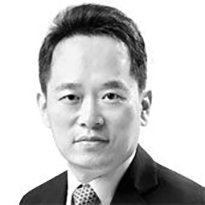An economy running on the rail laid by Rhee

Kim Dong-ho
The author is an editor of economic news at the JoongAng Ilbo.
The buzz over “The Birth of Korea,” a documentary film about the founding of South Korea under first president Syngnam Rhee, is set to be screened at the U.S. Congress next month. The audience in Korea was silently weeping as the film neared the end. I had been premature to think that the documentary would merely chronicle modern history. How the film was made with a shoestring budget of 300 million won ($224,551) is wondrous. I cannot imagine the trouble filmmaker Kim Deog-young must have undergone to find relevant materials.
The film was true to its English title, an odyssey looking back 70 years to show how a poor bisected country miraculously turned out. The dramatic evolution was adroitly captured in lively videos and interviews to keep the audience immersed throughout 101 minutes, making one forget it to be a documentary.
Due to the time constrains, the film could not fully account for Rhee’s visionary economic leadership. He was the architect of Korea’s capitalism and free market. The film featured his initiatives in education, farmland reform and nuclear energy. But his economic achievements were greater still. Half of 199 policies kept in the presidential archives were related to economic advancement. Rhee chanted for economic progress whenever he could. He was the president for the economy.
He planted the seeds of growth in every part of the country during his lengthy rule. From modernizing housing to establishing the fiscal basis, drawing foreign investment and building factories for industrialization, he initiated all possible programs to jump-start the underdeveloped post-colonization economy. Government procurement of crops to help farmers and basic labor law for workers was his idea. He was intent on driving industrialization to create jobs. He preached the textbook economic theory that earnings from work enable people to pay taxes and fuel fiscal ammunition.
The film also fell short of mentioning currency reform. Just as a nation cannot be formed without language and letters, an independent economy is impossible without sovereign currency. Korea continued to use the bills the Japanese colonial government issued after liberalization. Control over bills was Japan’s means of exploiting the Korean economy. Although sovereign currency was needed, Korea could not afford to make one after liberalization.
Rhee pushed strongly for the establishment of the Bank of Korea with the deep understanding that currency forms the root of an economic system. The central bank was founded on June 12, 1950 but became dysfunctional 13 days after its opening due to North Korea’s invasion later in the month. Rhee did not give up. He hastened the makeup of financial, monetary and foreign exchange systems during wartime to facilitate the issue of banknotes.
The first BOK banknotes worth 1,000 won ($0.75) and 100 won were issued from Japan’s National Printing Bureau on June 29, 1960 and were carried by an American military aircraft to arrive in Gimhae Airport in southern coast to be distributed in Daegu, where people were taking refuge during the war, on July 22.
Thanks to that fast action, the South’s economic system stayed intact during wartime despite the spread of fake money via North Korean soldiers. The old bills were outlawed, and only the BOK notes were accepted. The currency had to go through redenomination twice due to inflationary spikes during the war. Thanks to the timely earlier actions, the Park Chung Hee government was able to drive industrialization and modernization through the third currency reform. Currency is the fundamental state infrastructure necessary to collect taxes and bolster fiscal accounts, as well as to draw out the underground economic activities. Rhee had constructed the framework.
Park Chung Hee’s industrialization locomotion was able to run because Rhee had made the rails, according to the filmmaker. Koreans bore hostility towards outsiders after Japan’s colonization. But Rhee argued that if we did not buy any foreign products, no one would buy ours.
The basic design of heavy chemical industries is also Rhee’s work. The first fertilization factory was planned in 1955 on Rhee’s orders. A factory was initially due to open in 1958 in Chungju, North Chungcheong, but it was completed in April 1961 due to lack of funds. The factory helped the Park regime in fiscal terms.
The pinnacle of his leadership was the signing of the mutual defense treaty with the United States. America wanted to leave the Korean Peninsula after Korea was liberalized. Rhee, however, argued for continued U.S. military presence to defend against Communist forces well before war broke out. The North’s invasion proved Rhee’s foresight. Korea was able to come this far, near the advanced ranks, all thanks to its security and economic foundations. A satellite map of East Asia in the early part of the movie juxtaposed a dark North Korea beside an illuminated South. It was Rhee who set the grounds for that stark difference. We must not forget that our economy is rolling on the rails Rhee laid.










with the Korea JoongAng Daily
To write comments, please log in to one of the accounts.
Standards Board Policy (0/250자)